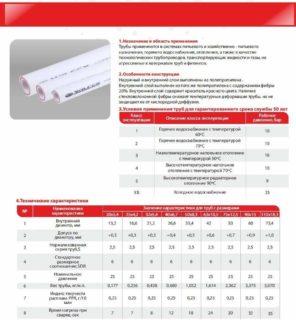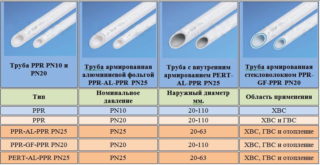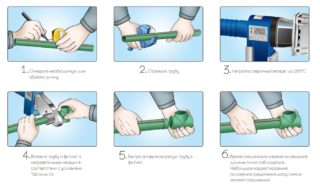The demand for metal products for pipelines is gradually decreasing, since these are very bulky structures, during the installation of which it is necessary to use heavy equipment and use welding. Instead, you can use plastic pipes, which are easier to install and more durable in operation. In addition, plastic does not chemically react with liquids, so drinking water does not lose its qualities and is not contaminated with harmful compounds.
Scope of polypropylene pipes for hot water supply and cold water supply

Some of the most popular are polypropylene pipes for hot and cold water supply. Polypropylene is the second most common material in the world after polyethylene. They are sometimes mixed during production, as polyethylene has a higher degree of viscosity and is resistant to freezing. To prevent polypropylene pipes from cracking in the cold or under the influence of cold water, it is necessary to choose the right brand of products - the composition of the material for hot and cold water supply is different.
One of the factors by which buyers choose this type of plastic is the price. Pipes are made using special equipment. The raw material for production is propylene gas - a toxic substance with a low melting and boiling point. It is obtained in the process of oil refining or in the coking of coal. It is considered a harmful substance, when exposed to a person, coma and death can occur.
Unlike the raw materials, the pipe material is absolutely safe for humans and the environment.
Isotactic polypropylene, from which pipes for water supply are made, are designated with the IPP marking. They are used in home sewage systems and multi-storey buildings. The strength of the material depends on how high the temperature of the pumped liquid in the system. It is not recommended to increase the pressure in pipes with hot water, the temperature of which is about 90 degrees, since polypropylene becomes viscous and at a pressure above 6 bar, the pipe may burst.
Types of polypropylene pipes
For hot water supply and cold water supply, a different composition is used for the production of pipes. Distinguish between finished products by material and method of reinforcement.
- Random copolymer, designated PP-R, is suitable for hot water, melts at 170 degrees, breaks at minus 20 degrees. With constant exposure to hot liquid of 95 degrees with short-term drops of up to 110 degrees, the service life is about 5 years.
- PP-R-CT is a novelty from German manufacturers, which has very high strength values. Service life at 110 degrees and short-term drops up to 130 degrees is about 15 years.
- Block copolymer - PP-B - intended for cold water supply.
- Homopolypropylene - PP-H - resistant to high pressure, but suitable for cold liquids. Most often used in industrial plants. Melts at 140 degrees, breaks at 0 degrees.
- Cross-linked polypropylene is a rather expensive material with high strength values.
For the outdoor system, you need to choose pipes with a coating that protects them from ultraviolet radiation.
Reinforcement reduces the coefficient of thermal expansion; therefore, products have a higher strength than unreinforced ones. There are several ways:
- using fiberglass;
- aluminum foil, which is placed closer to the inner diameter of the pipe;
- aluminum foil placed closer to the outer diameter;
- using composite materials.
Products with composites and fiberglass are considered to be of the highest quality.
Specifications
- the length of all products is predominantly the same - 6 m;
- the diameter of polypropylene pipes for water supply can be selected from 15 to 1200 mm, depending on which house the pipes are purchased for;
- marking allows you to determine for which water the products are intended, as well as the maximum pressure in the system;
- inner diameter helps to calculate the volume of water per unit of time;
- wall thickness - products designed for high pressure will have thicker walls.
The technical characteristics of low-quality products are very different from the factory ones, therefore, when trying to save money, difficulties in operation may arise.
Requirements in accordance with GOST
There are quality standards for plastic products:
- Polypropylene pipes are available only with a circular cross-section, this configuration contributes to increased strength in pressure systems.
- The products can be used both for industrial purposes and in home systems, as well as high-rise buildings.
- Polypropylene is suitable for industrial and drinking water at the same time.
- The pipes can withstand the pressure of the liquid, depending on the marking.
Pipes can be single-layer or multi-layer.
PP pipe marking
- PN10 - maximum pressure 1 MPa. They are used for arranging a warm floor in a room where the temperature of the liquid is not more than 45 degrees, as well as for cold water. Outside diameter 20 to 110 mm, inner diameter 1.9 to 10 mm.
- PN16 - maximum pressure up to 1.6 MPa. Withstands temperatures up to 60 degrees. It is used for the construction of a warm floor.
- PN20 - designed for pressure up to 2 MPa, the permissible temperature at this pressure is 80 degrees.
- PN25 - pipes with reinforcement designed for heating systems with pressures up to 2.5 MPa. Permissible temperature up to 100 degrees. Used in industrial systems.
When selecting products, it is necessary to take into account two parameters - pressure and resistance to heating, since a pipe with a strong temperature difference can lengthen by 15 cm. For hot water supply, reinforced products are often bought.
Standard sizes
The sizes of polypropylene pipes for cold and hot water supply are selected taking into account where they will be used.
Home systems use products with a diameter of 20 to 32 mm. If the length of the water supply is less than 10 m, a 20 mm pipe is suitable. If from 10 to 30 m - 25 mm, over 30 meters - 32 mm.
The diameter also affects the throughput of the system, therefore, when choosing it, the number of residents in the house and the volume of water consumption are taken into account. With a large number of turns and branches, it is advisable to choose a wider diameter. Also in pressure systems.
When arranging a warm floor, a diameter of 16-18 mm is used, for supply communications - at least 20 mm, when organizing risers - at least 25 mm.
Criterias of choice
The main recommendation when buying polypropylene pipes is to select products from one batch of one manufacturer. The composition of the substance can partially change and the quality of pipes in different deliveries will be different. This will affect the butt joints and the durability of the structure. The purchase of pipes from different manufacturers can lead to the fact that the connecting elements are unsuitable due to the difference in size. Each manufacturer has its own recipe for the substance, a discrepancy can lead to the failure of the entire plumbing system.
It is also worth paying attention to the following indicators:
- The calculated temperature of the fluid in the system.For hot water supply, it is better to select reinforced products.
- Estimated pressure. When heated, the material becomes weaker and may burst.
- The diameter should correspond to the section on which the pipes are mounted.
It is not worth saving if there are short-term surges in temperature or pressure in the system, which sometimes happens in centralized systems. In this case, it is better to buy reinforced, expensive polypropylene, which has a longer service life.
In domestic systems, where the pressure usually does not exceed 1 MPa, ordinary pipes can be used, but follow the manufacturer's instructions for which water the product is intended for - hot or cold.
Installation features
To install a polypropylene pipe system, you will need the following tools:
- pipe cutter;
- soldering device.
It should be borne in mind that when measuring, those areas that will be soldered into the corners or couplings are minus. This is approximately 15 mm.
Installation stages:
- Measurements of the sections through which the pipes will pass.
- Cutting and marking with a pencil the correct position of the fittings, since after the plastic has hardened, the incorrect position cannot be corrected.
- Both parts are heated on a special pipe soldering device, then connected along the outlined lines and held for 6 seconds.
From the moment of heating to the connection, no more than 4 seconds should pass, otherwise the material cools down and the quality of the joint will be low, in this place water can subsequently flow. Before heating, the ends of the pipes are degreased with alcohol or gasoline.
Along the route of the line, plastic clips are installed to fix the pipes. They should not wrap tightly around the product to compensate for thermal expansion. The connections are considered non-separable, therefore, if a section of the line is damaged, it must be completely replaced.
Advantages and disadvantages
There are many advantages of polypropylene pipes and structures that can be made using them:
- resistance to corrosion, due to which the water will be clean;
- resistance to biologically active substances - acids or alkalis;
- low thermal conductivity - no heat loss;
- simple installation - you can create a system of any complexity;
- smooth inner surface, so that sediments do not accumulate inside and high hydraulic pressure is not created;
- low cost.
There are also disadvantages to polypropylene, but there are few of them:
- you need to carefully select the material so that it is suitable for specific operating conditions;
- special tools are used for installation, so they will have to be bought or rented.
It is possible to buy low-quality products, so it is recommended to choose proven points of sale.
Prices for polypropylene pipes and fittings for water supply depend primarily on the brand of the manufacturer. Imported counterparts are more expensive, but they can be upgraded with new additives and additives that affect strength and increase service life in extreme conditions.











